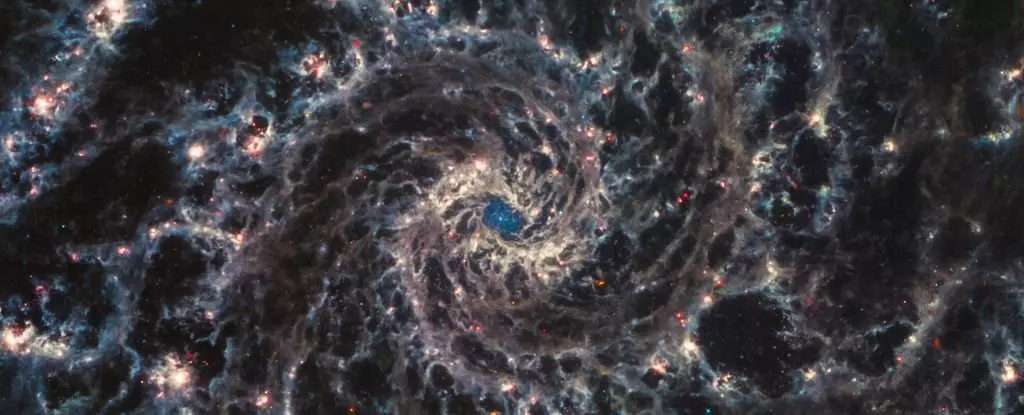Three years ago, the landscape of astronomical observation shifted dramatically with the successful launch of the James Webb Space Telescope (JWST). Unlike its predecessor, the Hubble Space Telescope, which has provided stunning images since the 1990s, the JWST was designed to delve deeper into space and time, promising to uncover secrets locked away in the universe’s early stages. Built over a span of three decades, this state-of-the-art instrument has proven to be a crucial tool in our quest to understand cosmic phenomena, particularly the formation of stars and galaxies. In this article, we will explore what the JWST has uncovered about the early universe and the enigmatic objects it has revealed.
At its operational core, the JWST utilizes infrared technology, allowing it to observe celestial bodies obscured by dust and gas. This capability has facilitated an unprecedented look into the distant past, unveiling galaxies that formed when the universe was merely 300 million years old—a fraction of its current age. One of the telescope’s astounding findings includes a galaxy that possesses a mass approximately 400 million times that of our Sun, indicating that star formation in this primitive epoch was remarkably rapid.
However, these early cosmic entities present a perplexing contrast. While one would anticipate that such massive galaxies should be shrouded in dust—a byproduct of stellar explosion that absorbs blue light—the JWST’s observations reveal these galaxies to be strikingly bright and predominantly blue. This anomaly raises questions about the lifecycle and characteristics of early stars. Did they experience supernova events that expelled dust, or was the environment so intense that any dust formed was immediately destroyed?
Moreover, the JWST has deciphered intriguing chemical compositions within these early galaxies, notably a higher-than-expected amount of nitrogen relative to other metals. This suggests that the processes responsible for the synthesis of elements in the universe are more complex than previously understood. The presence of nitrogen in such quantities hints at conditions in the early universe that challenge existing models of chemical evolution, compounding our ignorance regarding the mechanisms that laid the groundwork for life as we know it.
This brings us to a critical aspect of the JWST’s findings: its potential to reshape our understanding of star formation and element distribution throughout the cosmos. Current models must be revisited and refined to accommodate the evidence emerging from these distant observations.
The telescope’s capability has enabled astronomers to use massive clusters of galaxies as natural ‘magnifying glasses’ to uncover the faintest light emissions from these distant celestial bodies. With each discovery of a new galaxy, particularly those emitting an unexpected abundance of energetic photons, we inch closer to understanding the mechanisms behind galaxy formation and, crucially, the end of the so-called “cosmic dark ages.”
In particular, the JWST has not yet discovered the threshold of faintness beyond which galaxies cease star formation, but it has revealed far more small galaxies than anticipated. This underscores the notion that smaller, less luminous entities may have been instrumental in transitioning the universe from dark to light following the Big Bang.
One of the more astonishing finds includes what are dubbed “little red dots,” sources of compact light that defy conventional classification. Initially surmised to be massive galaxies, the observations reveal characteristics that imply a more intricate relationship between stars and the supermassive black holes believed to pervade such structures. The red dots exhibit behaviors typical of supermassive black holes, like the rapid movement of surrounding gas, but absent the expected X-ray emissions. Are these dots merely transitional states within the lifecycle of galaxies and stars, or do they represent an entirely new class of cosmic objects?
Additionally, JWST’s advanced observational tools have identified massive “corpses” of galaxies dying in the wake of intense star formation, with some forming prior to 700 million years into cosmic history. Such massive bodies challenge existing models of galaxy formation, sparking debates among cosmologists about the nature and properties of dark matter.
As the JWST continues to uncover a plethora of data about our universe, it not only affirms some long-standing theories but also reveals substantial gaps in our understanding. The findings thus far hint at a mosaic of cosmic history that is still emerging, suggesting that the universe’s complexity surpasses our current models.
With each new discovery, we are prompted to question our knowledge about the evolution of galaxies, star formation, and the very elements that comprise our existence. The JWST stands not just as a tool for observation but as a harbinger of a new age in astronomical exploration. What other mysteries lurk among the stars? The journey has just begun, and the future holds the promise of unprecedented revelations that will continue to reshape our understanding of the cosmos.


Leave a Reply